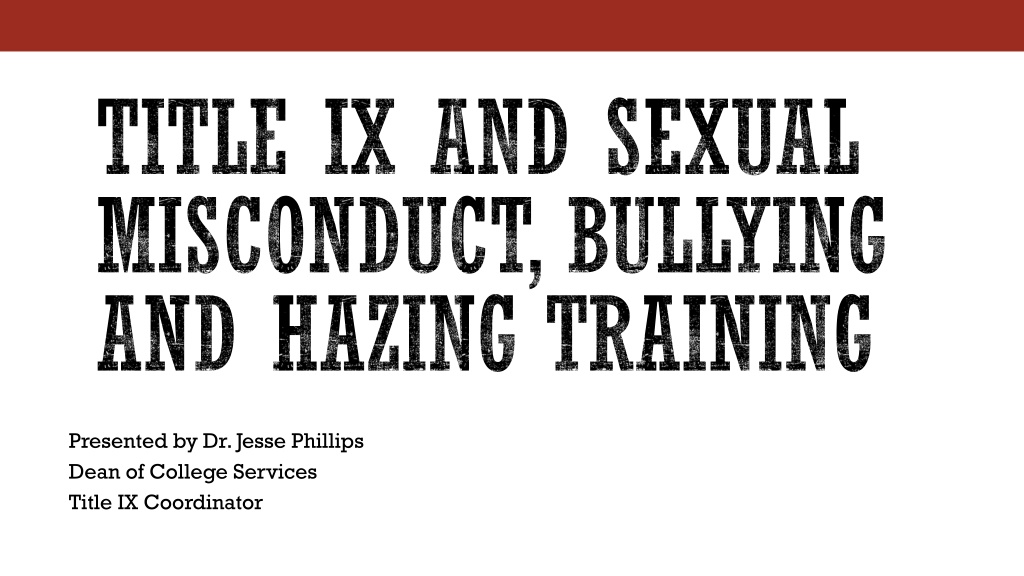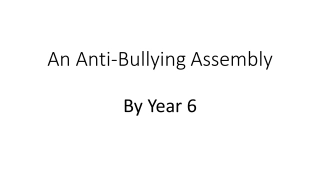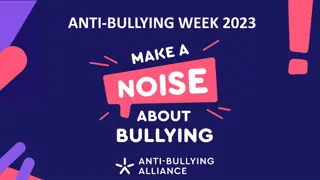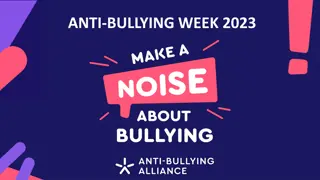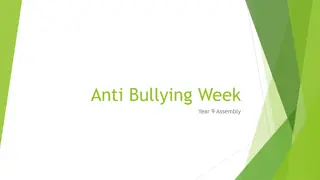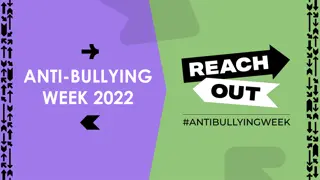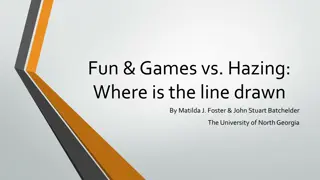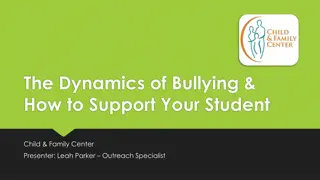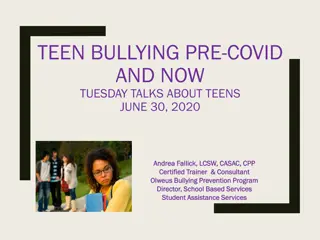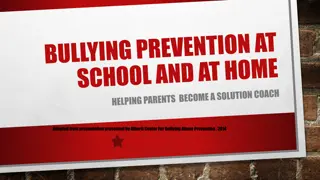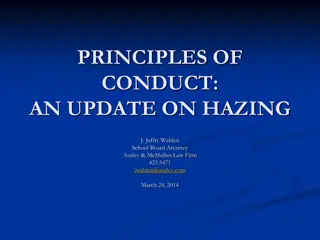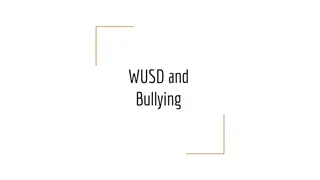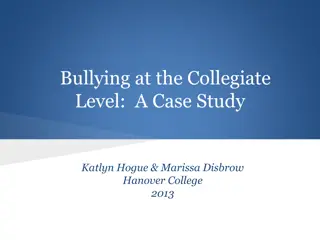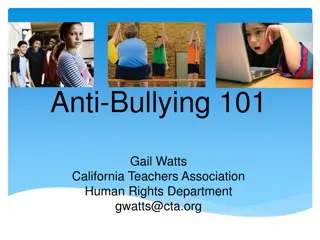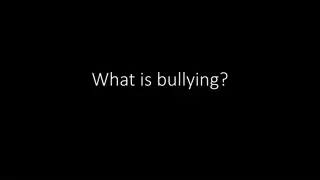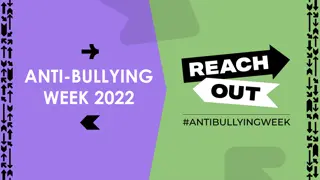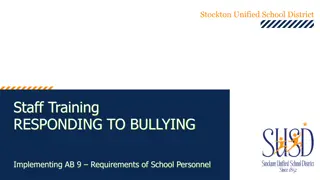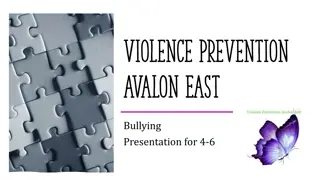Understanding Title IX, Bullying, and Hazing: Training Overview
Dr. Jesse Phillips presents comprehensive training on Title IX regulations, bullying prevention, and hazing awareness. Learn about the significance of Title IX in educational settings, identify bullying behaviors, and understand the impact of cyberbullying. Discover resources for bullying prevention and ways to address hazing practices effectively.
Download Presentation

Please find below an Image/Link to download the presentation.
The content on the website is provided AS IS for your information and personal use only. It may not be sold, licensed, or shared on other websites without obtaining consent from the author. Download presentation by click this link. If you encounter any issues during the download, it is possible that the publisher has removed the file from their server.
E N D
Presentation Transcript
TITLE IX AND SEXUAL MISCONDUCT, BULLYING AND HAZING TRAINING Presented by Dr. Jesse Phillips Dean of College Services Title IX Coordinator
TITLE IX No person in the United States shall, on the basis of sex, be excluded from participation in, be denied the benefits of, or be subjected to discrimination under any education program or activity receiving assistance. Federal financial
BULLYING Bullying is an ongoing and deliberate misuse of power in relationships through repeated verbal, physical and/or social behaviour that intends to cause physical, social and/or psychological harm. It can involve an individual or a group misusing their power, or perceived power, over one or more persons who feel unable to stop it from happening. What bullying is not single episodes of social rejection or dislike single episode acts of nastiness or spite random acts of aggression or intimidation mutual arguments, disagreements or fights. 3
CYBER BULLYING Cyberbullying is bullying that takes place over digital devices like cell phones, computers, and tablets. Cyberbullying can occur through SMS, Text, and apps, or online in social media, forums, or gaming where people can view, participate in, or share content. Cyberbullying includes sending, posting, or sharing negative, harmful, false, or mean content about someone else. It can include sharing personal or private information about someone else causing embarrassment or humiliation. Some cyberbullying crosses the line into unlawful or criminal behavior. The most common places where cyberbullying occurs are: Social Media, such as Facebook, Instagram, Snapchat, and Tik Tok Text messaging and messaging apps on mobile or tablet devices Instant messaging, direct messaging, and online chatting over the internet Online forums, chat rooms, and message boards, such as Reddit Email Online gaming communities 4
BULLYING RESOURCES CYBER BULLYING VIDEO UPSTANDER VIDEO https://www.stopbullying.gov/ https://www.stopbullying.gov/cyberbullying/preventi on Bullying Prevention Consultation Line 1-866-716-0424 5
HAZING Hazing is any act that, as an explicit or implicit condition of recruitment, admission, or initiation into, affiliation with, or new or continued membership status within a group, team, organization, living group, or academic group or cohort, does one or more of the following: Causes, encourages, or compels another person to engage in any activity that could reasonably be perceived as likely to create a risk of mental, physical, or emotional distress or harm; examples include but are not limited to: a.Undertake acts of servitude or menial tasks; b.Undergo undue financial expenditures; c. Engage in acts relevant to those of the group (for example practice or training activities), but in a manner that a reasonable person would consider excessive or dangerous; d. Abuse, humiliate, degrade, or taunt another person or persons. 6
Involves any of the following: a.Consumption of alcohol or drugs; b.Consumption of unpalatable substances, or palatable substances to excess; c.Damage to or theft of property, or any other illegal act; d.Violation of any University policy. Subjects any other person (including an existing member or cohort of existing members of the group) to any of the above activities. Hazing can occur on or off campus, in person or in virtual settings. The individual subjected to hazing does not need to regard or identify the act as hazing. The fact that an individual does not object to and/or appears willing to participate in the activity, does not signify the conduct is not hazing. 7
Examples of hazing Joining a group should never involve: sleep deprivation eating gross stuff acts of exertion isolation from the group acts of servitude Alcohol 8
HAZING RESOURCES https://stophazing.org/ https://stophazing.org/policy/state-laws/pennsylvania/ PA STATE HAZING LEGISLATION 9
OTHER LEGISLATION Violence Against Women Act VAWA Jeanne Cleary Act Clery SEXUAL MISCONDUCT POLICY Available on the VFMC website Applicable to Faculty, Staff, Students, and Guest 10
WHAT IS SEXUAL MISCONDUCT? The overall term includes Gender Discrimination Sexual Assault Sexual Harassment Sexual Exploitation Dating Domestic Violence Stalking
WHAT IS SEXUAL ASSAULT?
WHAT IS SEXUAL ASSAULT? Sexual assault occurs when a person is forced, intimidated or coerced into a sexual act, or when a person is unable to give consent. Consent is AFFIRMATIVE!
CONSENT- ITS SIMPLE AS TEA Tea 15
WHAT IS SEXUAL ASSAULT? Engaging in sexual activity with an unconscious or semi-conscious person. Engaging in sexual activity with someone who is asleep or passed out. Engaging in sexual activity with someone who has said no or has otherwise expressed an unwillingness or refusal to engage in sexual activity. Engaging in sexual activity with someone who is vomiting, unable to stand without assistance, or has to be carried to bed. Allowing another person to engage in sexual activity with your partner without his or her consent. Requiring any person to perform any sexual activity as a condition of acceptance into a club, athletic program or any other organization affiliated with the University. Telling someone you will out them if they don t engage in sexual activity (e.g., threatening to disclose the person s sexual orientation without their consent). Telling someone you will fail them or give them a grade different from what they deserve if they don t agree to engage in sexual activity. Facilitating or assisting in a sexual assault including purchasing or providing alcohol or drugs to further a sexual assault. 16
WHAT IS SEXUAL HARASSMENT?
WHAT IS SEXUAL HARASSMENT? Unwelcomed sexual advance, request for sexual favors, or other unwanted conduct of a sexual nature. Verbal Non-verbal Graphic Physical Suggestive
WHAT IS SEXUAL HARASSMENT? Calling someone by a demeaning name Giving someone unwanted gifts of a sexual nature Displaying sexually suggestive materials or sending notes, email, or jokes to a person that are sexually explicit Touching someone sexually without their consent Massaging someone without permission Brushing up against someone repeatedly Continuing to ask out a person who already has said he or she is not interested. Exposing ones genitalia or breast to another person.
WHAT IS STALKING? Stalking occurs When a person engages in a course of conduct That is directed at a specific person Under circumstances that would cause a reasonable person to fear bodily injury or to experience substantial emotional distress. Includes Cyberstalking
WHAT IS DATING & DOMESTIC VIOLENCE?
WHAT IS DATING & DOMESTIC VIOLENCE? Includes (but is not limited to) Physical Violence Sexual Violence Psychological Violence
WHAT IS DATING & DOMESTIC VIOLENCE? Taking away a person s cell phone during an argument so the person cannot call a friend or the police for help. Threatening to commit self-harm if another does not do what is asked. Threatening to physically assault someone the individual is dating if the person does not do what is asked. Hitting, punching, pinching, slapping, or choking someone with whom the person is intimately involved. Violating a protective order. Harming a person s animals or children while in an intimate relationship. Conduct directed at a specific person under circumstances that would cause a reasonable person to fear bodily injury or to experience substantial emotional distress. 24
COMMON VICTIM RESPONSES Lack of physical resistance, attempts to flee or to summon help Difficulty sequencing the event Minimization Gaps in memory; inability to remember important aspects of the event Protecting perpetrator; continuing contact with perpetrator Intentional omissions or embellishment Lack of emotion or odd/inappropriate affect
COMMON VICTIM RESPONSES (CONT.) Denial Isolation Self-blame Attempts to regain control or reframe what happened Coping behavior
RE-VICTIMIZATION The increased risk for continued violence and abuse that a sexual assault victim may be subject to, due to posttraumatic stress and other psychological and physical reactions to the sexual assault. You can help prevent re-victimization and reduce the effects of trauma by recognizing these symptoms and treating the victim with sensitivity. Decline in academic or job performance; Increased anger and hostility; Social withdraw and depression; A feeling of anxiety, fear and/or guilt; and Physical symptoms, such as insomnia, fatigue, memory loss, aches/pains
SUPPORTIVE MEASURES Must be equitable for both complainant and respondent Non-disciplinary Non-punitive Appropriate Protect safety of all parties Can be no contact-order, class schedules, room assignments 29
SHOULD THE COMPLAINANT REPORT? Reporting ensures that victims receive resources whether or not an investigation is conducted. Reporting allows the Title IX Coordinator to monitor trends and patterns of incidents and track victim contacts. 30
NON-RETALIATION It is a violation of the Sexual Misconduct Policy to retaliate in any way against someone because they have filed a report. It is a violation of the Sexual Misconduct Policy to retaliate in any way against the person who is alleged to have violated the policy. It is a violation of the Sexual Misconduct Policy to retaliate in any way against someone who participated in an investigation. 31
RESPONDING TO COMPLAINANTS Before the cadet reveals any information that they may wish to keep confidential, inform them of your obligation to report all complainants of sexual misconduct. 1. Advise the cadet that VFMC will maintain privacy and will only disclose as much information as needed in order to assist the individual. 2. Offer the student the option to discus the information confidentially with Counselor Dorothy Lowery @dlowery@VFMC.edu 3. Listen carefully and be familiar with the policy including procedures. IT IS NOT YOUR RESPONSIBILITY TO INVESTIGATE OR DETERMINE WHAT OCCURRED. 4. Assure the student they will not be retaliated against for coming forward. 5. Report all complaints to the Title IX Coordinator (jphillips@VFMC.edu). Failure to report a complainant could result in serious consequences for VFMC. 6.
REPORTING OPTIONS FOR VICTIMS I want help and care but not to report I want to report to police for criminal charges I want to tell police to receive additional information but no charges I want to tell a trusted faculty or staff member I want to report to VFMC for charges
WHERE TO REPORT Deputy Title IX Coordinator Eric Saul Melon Hall esaul@VFMC.edu Title IX Coordinator Jesse Phillips Medenbach Hall 610-989-1467 jphillips@VFMC.edu Deputy Title IX Coordinator Aaron Barkley abarkley@VFMC.edu 34
THE PROCESS Investigation Interview Complainant Interview the person who made the report if different than the Complainant Interview Witnesses Interview Respondent Collect relevant information Messages Pictures Social Media Posts Cards Access Records Surveillance Camera Footage
THE PROCESS Review Investigative Report At the conclusion of the investigation, each party has an opportunity to review the preliminary report Charges Identification of persons interviewed Summary of information collected Summary of statements Complainant and Respondent have opportunity to provide a response to preliminary report Additional questions to ask other parties or witnesses New evident The impact of the situation
USE NON-JUDGMENTAL LANGUAGE Not asking questions that imply the victim was responsible for what happened. What were you wearing? Did you say no? Were you drinking? Avoiding labels, such as abuse or rape. Using language that is behaviorally descriptive, such as hitting or touching sexually; and Using supportive language that indicates you believe the victim. Thank you for sharing. What can I do to help you during this time?
WHEN A VICTIM BECOMES A COMPLAINANT Title IX Coordinator will send outreach to the reporting party and/or victim Receive rights Receive resources Advises of the option to proceed Notification of Investigation Receive a copy of the complainant Receives notification of retaliation and confidentiality Informed of supportive measures
WHEN THE ALLEGED BECOMES A RESPONDENT Notification of Investigation Receive rights Receive resources Receive a copy of the complainant Receives notification of retaliation and confidentiality Informed of supportive measures
WHEN A VICTIM BECOMES A COMPLAINANT Case Assessment and Determination of Supportive Measures Steps VFMC may take during an investigation to ensure equal access to educational programs and activities, and protect the campus community. No contact order Relocation of academic, living or work environments Walking escorts Interim Suspension from housing or classes
AMNESTY Applies to any student who Actively seeks to contact a member of the VFMC Staff or certified emergency medical personnel for a medical emergency Where their or another person s health or safety may be in jeopardy Recognized VFMC organizations, student groups, or students that may be hosting or sponsoring an event Only to VFMC policies not criminal violations Individuals may still be required to participate in educational and/or health requirements. 41
SANCTIONS AND APPEALS When the Respondent is a Student / Staff Investigative Report is provided to an Administrative Panel to determine sanctions If an appeal is submitted, an Administrative Panel will determine if appeal has merit. Different set of individuals that determined sanctions
FORMAL COMPLAINT A formal complaint of Title IX sexual harassment means a document filed by a complainant or signed by the Title IX Coordinator alleging sexual harassment against a respondent and requesting that the school investigate the allegation of sexual harassment. Documented Not formal if oral Could be emailed or filed with Title IX Coordinator Must go through an official process 43
STUDENT GRIEVANCE PROCESS The grievance procedure may be used to resolve any student complaint except those that are covered by a specific college procedure (e.g. College Code of Conduct Process, Student Academic Grievance Procedures, Harassment Policy, etc.) Informal Resolution- seek to resolve issue informally Formal Grievance- File a non-academic grievance form Appeal- Provost will attempt to resolve issue if student is dissatisfied with the formal grievance decision. 44
